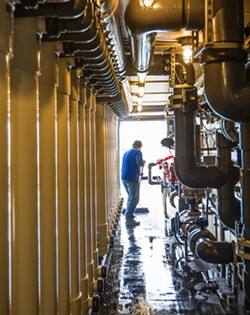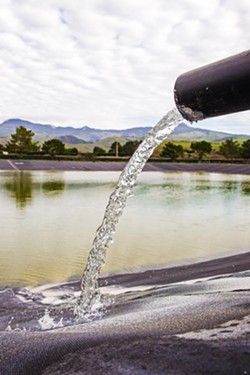Getting a straight answer about the future of Cambria's water situation isn't easy.
That's, in part, thanks to the town's water reclamation facility, which has yet to be permanently permitted after being built in 2014 under an emergency permit; doesn't produce water for residents; and is plagued by a rocky history.
"It's like a labyrinth where you never quite get to the answer," said Christina Galloway, who serves on the North Coast Advisory Council's (NCAC) land use committee. "People just want to know what you're asking to be able to do with this thing and what that means for people in Cambria. Is this for development or is it to sustain our existing water supply?"
Galloway has been a Cambria resident for two years, and throughout that time, she's heard many stories about the facility and its origins. Those rumors include one that has stuck to the Cambria Community Services District (CCSD) since the project's beginning: The allegation that the water facility was called an "emergency" project, but it was really built as a ploy to lift the building moratorium in Cambria.

- Cover File Photo By Jayson Mellom
- CLEAN UP Since 2014, the Cambria CSD has had a wastewater treatment plant that it hasn't really been able to use due to environmental issues and permitting problems.
The CCSD's board approved building and paying for the facility amid public outcry, and some residents don't trust the district or its intentions. While a contingent of residents believe the facility should sit unused and never get permitted, others disagree.
"It has been a very complicated and very contentious issue," said CCSD board member Harry Farmer, who was first elected in 2016. "Here we are, basically 10 years after the facility was built, and we still can't operate the facility. ... Although, we could operate it in the case of an emergency."
During the May 15 NCAC meeting, Galloway, who also serves as the environmental representative, asked CCSD General Manager Matthew McElhenie for an update—and to keep the answers as present and future focused as possible.
"Our goal is to operate it under an unrestricted permit," McElhenie said at the meeting. "What we're really trying to do is allow us to pump into the dry season with a replenished aquifer. When we start to enter that dry season, we want to start to operate that facility."
The goal is to prevent another "dire emergency." But, he added, "a lot of this still remains to be seen about how this all plays out." Growth, McElhenie said, isn't really on the table.
The water reclamation facility, which was once known as the emergency water supply project, was approved under an emergency coastal development permit thanks to then Gov. Jerry Brown's drought state of emergency proclamation in 2014. Cambria's water situation was considered to be a stage 3 emergency at the time, the highest it could be. Reviewing the plant's environmental impacts came after it was constructed—an ongoing process that has yet to be completed.
California Coastal Commission Senior Environmental Scientist Tom Luster has been involved with Cambria water issues since before the CCSD started looking into "doing a desal plant." The facility was built to treat brackish water—a mix of salty and fresh groundwater and wastewater—and inject that treated water back into CCSD wells.
Luster told New Times that an emergency permit is meant to allow agencies to act quickly if there's an immediate safety issue, danger to life, or something similar.
"After the emergency is dealt with, the applicant has to come back and apply for a permit," Luster said.
The CCSD applied to San Luis Obispo County (the lead local agency) for that more permanent permit in July 2020, but hit environmental issues in the review process.
While SLO County is the lead agency that will decide on the facility's coastal development permit, McElhenie and the CCSD staff have been working with both the county and the commission on the current iteration of the draft permit application.
"Our assumption is that it will get appealed to the Coastal Commission," McElhenie said at the NCAC meeting. "So, we do want to hear from the Coastal Commission even though it's not there yet."

- File Photo By Jayson Mellom
- BRINY The Cambria CSD's water reclamation facility application stalled due to issues with its brine disposal method, which originally relied on this evaporation pond that's had flooding issues.
The SLO County Department of Planning and Building emailed New Times a response to a voicemail asking for comment.
"We do not have information to share about the project since the Cambria CSD has not submitted their application yet," the email stated.
Some Cambria residents have brought up the commission's response to an unofficial draft of the application as proof that, once again, the CCSD isn't doing things right. In an April letter to the CCSD, commission staff pointed out remaining unaddressed issues.
"They have some challenges there, and we've talked to them quite often about those challenges and what they're going to do to resolve them," Luster said.
Luster said the project has had several leads over the last 10 years and he's met with many board members and staff. The current iteration has provided the commission with about three drafts over the last year.
"That's good," he said. "There are a couple of issues that they still haven't quite got to, but at least they're reaching out."
Luster said the CCSD still needs to figure out how to mitigate the last 10 years of impacts on the 6 acres of Environmentally Sensitive Habitat Area (ESHA) where the facility was built. ESHA supports endangered species such as the red-legged frog and California steelhead. ESHA is important, Luster said, because "it's been in decline."
The CCSD also has to finish an instream flow study in San Simeon Creek, which McElhenie told NCAC will be completed this summer. That study and clarity about how much groundwater the CCSD wants to pump through the facility will help determine how those operations would impact the creek, its habitat, and privately owned wells—which the CCSD would also need to mitigate.
Another big issue is how to deal what's left over from treating the water, known as brine. A large evaporation basin was the intended disposal mechanism, but it had leaks and flooding issues, so the Regional Water Quality Control Board shut it down, Luster said. One option is trucking the brine to another facility, which McElhenie told New Times was cost prohibitive for "extended periods of operation."
A pilot project to chemically and heat-treat that brine to remove dissolved solids and eliminate industrial wastewater discharge is in the works, McElhenie said. If it works well, that zero liquid discharge project funded by the National Alliance for Water Innovation would cost a fraction of the price to haul the brine away.
Luster said the pilot project would likely need a permit as well.
While McElhenie admitted that the CCSD still has a long way to go in addressing issues such as mitigating ESHA impacts, he asserted that the CCSD board and the district's administrative leadership is different than it's been in the past. Staff is actively engaged with the county and the commission so the CCSD can eventually submit an application that gets approved.
"We've changed course philosophically," McElhenie told the NCAC. "We're ready to make some moves, but it's a big, long convoluted issue."
CCSD board member Farmer said that since 2014, the application process has been "problematic," as has the district's relationships with local and state agencies.
"Our general manager is making an effort to remedy that situation," Farmer said.
He estimates that the district has spent between $17 million and $18 million on the facility over the last decade—that includes the initial $9 million loan with $4 million in interest the CCSD and its ratepayers are putting $660,000 to every year until 2034.
"It's just sitting there. It should at least be permitted. How it will be used after that is probably where the rubber meets the road, so to speak," Farmer said. "It should only be used in an emergency. ... This is my humble opinion." Δ
Correction: This story was updated to correct the full name of NCAC—the North Coast Advisory Council—and the correct name of the desalination facility at its start—the emergency water supply project. The original version of this article referred to NCAC as a committee and the facility's initial name as the emergency water sustainability project. New Times regrets the errors.
Reach Editor Camillia Lanham at [email protected].
Comments
Showing 1-1 of 1